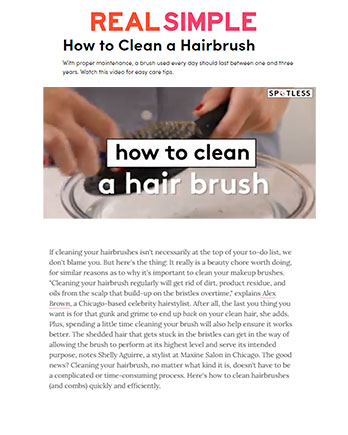Real Simple July 8, 2021
 Real Simple
Real Simple
Hair
How to Clean a Hairbrush
With proper maintenance, a brush used every day should last between one and three years. Watch this video for easy care tips.
If cleaning your hairbrushes isn't necessarily at the top of your to-do list, we don't blame you. But here's the thing: It really is a beauty chore worth doing, for similar reasons as to why it's important to clean your makeup brushes. "Cleaning your hairbrush regularly will get rid of dirt, product residue, and oils from the scalp that build-up on the bristles overtime," explains Alex Brown, a Chicago-based celebrity hairstylist. After all, the last you thing you want is for that gunk and grime to end up back on your clean hair, she adds. Plus, spending a little time cleaning your brush will also help ensure it works better. The shedded hair that gets stuck in the bristles can get in the way of allowing the brush to perform at its highest level and serve its intended purpose, notes Shelly Aguirre, a stylist at Maxine Salon in Chicago. The good news? Cleaning your hairbrush, no matter what kind it is, doesn't have to be a complicated or time-consuming process. Here's how to clean hairbrushes (and combs) quickly and efficiently.
How to Clean a Hairbrush
No matter the shape, size, or bristle type, both experts we spoke with agree that the same (very easy) cleaning method applies. Start by removing all of the stray hairs—you can do this with either a comb or with your fingers, lightly pulling all of the hair from one end of the brush to the other, says Aguirre. Next, you'll need warm water and some type of cleanser; Aguirre uses shampoo, while Brown likes to use antibacterial dish soap. Apply a drop or two of either one onto the bristles, add a bit of water, and get the brush nice and soapy. "You can use your hands to make sure the lather gets all over the bristles," says Aguirre. Just make sure that you're only 'scrubbing' the bristles one way, rather than in a back-and-forth motion in order to maintain their integrity, adds Brown. Do this for about 30 seconds to a minute, then rinse. And rinse. And rinse again. "You want to make sure there's no excess shampoo or soap on the brush, so keep rinsing until the water runs clear and you don't see any suds," Aguirre advises. Give the brush a good shake to get rid of excess moisture, then lay flat to dry, bristle side down, ideally overnight.
See below for a more detailed step-by-step process.
What You Need
- brush, comb (preferably one with a pointed handle), toothbrush, glass bowl large enough to fit brush, gentle shampoo, towel
Follow These Steps
- Perform Daily Maintenance Remove hair from your brush every time you use it. Hold the brush in one hand while grasping a comb in the other. If the comb has a pointed handle, hold the teeth (not the handle) and run the point of the handle through the bristles a few times to dislodge and remove any hair. Alternately, you can use the teeth of the comb to remove hair, raking them through the bristles and lifting the hair up and out. Discard the hair.
- Shampoo Your Hairbrush Once a month or so, shampoo your hairbrush to remove dirt, oil, and any built-up hair products. Holding the handle, swirl the head of the brush around in a bowl of warm water. Next, put a few drops of gentle shampoo on the bristles of a toothbrush and use the toothbrush to scrub the bristles and base of the hairbrush. Rinse the brush by swirling it around in the bowl of clean water. Tip: Don't soak your hairbrush in water as that could harm its cushion and any wooden parts.
- Dry Hairbrush Overnight Place the clean, wet brush on a dry towel with the bristles facing down to dry overnight.
How to Clean a Comb
Pull out any excess hair that may be stuck in between the teeth, then soak the comb in warm soapy water for a few minutes, says Brown. She adds that you can use an old toothbrush to help buff off any excess product build-up. Yes, it's that easy.
How to Clean a Hairbrush With Dandruff
If you're battling dandruff, the aforementioned brush-cleaning protocol still applies, you just want to do it more frequently. Whereas most people can get away with cleaning their hair brushes bi-weekly, try doing so weekly if you have dandruff, since you really want to make sure you're getting rid of that extra scalp-flaking, notes Brown. If you're finding that there's still residue stuck in the bristles, Aguiree says to let the brush soak in warm, soapy water for 10 to 15 minutes (this will give the soap a little more time to break down the build-up) before using your fingers to agitate the bristles.
If you have dandruff and want to deep-clean your comb, Brown recommends soaking it in warm water, along with one teaspoon each of white vinegar and dish soap. Let it soak for an hour, then rinse thoroughly with warm water.
